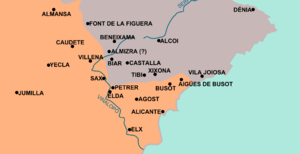Treaty of Almizra facts for kids
The Treaty of Almizra (also called the Treaty of Almiçra) was an important agreement signed in 1244. It was the third in a series of treaties between two powerful Christian kingdoms in Spain: the Crown of Aragon and the Crown of Castile. The main goal of these treaties was to set clear boundaries for where each kingdom could expand into the lands held by the Muslims (called Andalusia at the time). This helped prevent arguments and even wars between the Christian rulers.
This specific treaty was very important for defining the borders of the Kingdom of Valencia. James I of Aragon signed it on March 26, 1244. However, Alfonso X of Castile didn't officially agree to it until much later.
Contents
What the Treaty Decided
The Treaty of Almizra drew a clear line on the map. All the lands south of a line going from Biar to Villajoyosa, and passing through Busot, were set aside for Castile. This agreement largely stopped Aragon's expansion further south on the Iberian Peninsula.
Why This Treaty Was Needed
This treaty followed two earlier agreements: the Treaty of Tudilén and the Treaty of Cazorla. However, these earlier treaties were often broken. A key rule in those treaties was that neither kingdom should take land assigned to the other, or stop the other from getting their share.
When the Rules Were Broken
Despite the rules, both sides broke the agreement. For example, James I of Aragon conquered areas like Caudete, Villena, and Sax. These places were technically supposed to belong to Castile. At the same time, Prince Alfonso (who later became Alfonso X) held Xàtiva, which was in the zone assigned to Aragon. The Treaty of Almizra was an attempt to fix these problems and create a lasting peace.
History of the Treaty Document
The Treaty of Almizra was first mentioned in a famous book called Llibre dels fets. This book tells the story of James I of Aragon. However, the actual text of the treaty itself wasn't officially published until 1905.
Where the Treaty Was Signed
The treaty was signed in a place called Campo de Mirra. Today, there's a special monument there, built in 1977, that remembers this important event.
Later Changes to the Borders
Even after the Treaty of Almizra, the borders continued to change over time. In 1296, during a break in a war between Aragon and Castile, James II of Aragon conquered the Kingdom of Murcia.
New Treaties and New Borders
Later, the Kingdom of Murcia was divided. Parts of it, including areas like Medio Vinalopó, Bajo Vinalopó, L'Alacantí, and Vega Baja del Segura, became part of Valencia. This happened because of two new agreements: the Treaty of Torrellas in 1304 and the Treaty of Elche in 1305. These treaties further shaped the map of Spain.
See also
- In Spanish: Tratado de Almizra para niños


